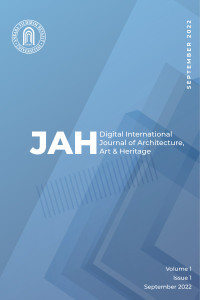SYMBOLIC DESIGN AND KITSCH PRODUCTION IN ARCHITECTURE IN A HYPERREAL POSTMODERN CONTEXT
SYMBOLIC DESIGN AND KITSCH PRODUCTION IN ARCHITECTURE IN A HYPERREAL POSTMODERN CONTEXT
Kitsch, Postmodernism, Hyperreality, Image use, Consumption Culture, Kitsch, Postmodernism, Hyperreality Image use, Consumption Culture,
___
- Akyıldız, E. C. (2020). Mimarlıkta kitsch ve estetik deneyim: Bosphorus city. Mimarlık ve Yaşam, 5(2), 517-528.
- Balık, D., & Allmer, A. (2015). This is not a mountain!: simulation, imitation, and representation in the Mountain Dwellings project. Copenhagen. arq: Architectural Research Quarterly, 19(1), 30-40.
- Berk, E. (2017). Halk zevki ve zevksizlik arasında: Bir kitsch sosyolojisine doğru . Journal of Ulakbilge Sosyal Bilimler, 5(14), 1205-1226.
- Binkley, S. (2000). Kitsch as a repetitive system: a problem for the theory of taste hierarchy. Journal of material culture. 5(2), 131-152.
- Birol, G. (2008). “Trafo” mu,“ev” mi? “Dekore edilen” trafo yapılarının düşündürdükleri. Journal of Megaron, 31-33.
- Boratav, O., & Gürdal, N. (2017). Disegno’dan kitsche sanatta fikir. Journal of Art-Sanat(7), 197-206.
- Bourdieu, P. (2018). Distinction a social critique of the judgement of taste. In Inequality Classic Readings in Race, Class, and Gender (s. 287-318). London: Routledge.
- Congdon, K. G., & Blandy, D. (2005). What? Clotheslines and popbeads aren't trashy anymore?: Teaching about kitsch. Studies in Art Education, 46(3), 197-210.
- Fındıklı, E. B. (2021). İdeolojik bir tema parkı olarak Eskişehir. Journal of Dîvân: Disiplinlerarası Çalışmalar(51), 81-113.
- Fırat, A. F., & Ulusoy, E. (2011). Living a theme. Consumption markets & culture, 14(2), 193-202.
- Garip, S. B., & Garip, E. (2015). Copying urban identity and pasting it on residential architecture:'themes' for gated settlements in İstanbul.
- Greenberg, C. (2011). Avangart ve Kitsch. Sanat ve Kuram, 577-587.
- Greg, C., & Molly, H. (2018). Faux real. Interiors, 9(1), 20-29.
- Gurallar, N. (2016). Tarihselcilik-tarihsicilik [Historicism]: Bir mimarlık terminoloji tartışması ve 2000’ler Türkiyesinde tarihsici mimarlık. METU Journal of the Faculty of Architecture, 32(2).
- İlkyaz, A. (2015). Çağdaş sanatın çıkmaz sokağı: Kitschin zaferi. İstanbul Aydın University Journal of the Faculty of Art, 1(1), 11-20. Kulka, T. (2015). Kitsch and art. Penn State Press.
- Kuyrukçu, E. Y., & Kuyrukçu, Z. (2015). Mimarlıkta yer(sizliğ)in Antalya’daki turizm yapıları üzerinden incelenmesi. Journal of Mimaran, 9(12), 27-33.
- Londos, E. (2006). Kitsch is dead—Long live garden gnomes. Home Cultures, 3(3), 293-306.
- Miller, D. (2006). Things that bright up the place. Home Cultures, 3(3), 235-249.
- Özaslan, N., & Akalın, N. (2011). Architecture and image: the example of Turkey. Middle Eastern Studies. 47(6), 911-922.
- Özel, F. B., & Mumyakmaz, A. (2018). Max Horkheimer ve Theodor W. Adorno’da Modern İnsan ve Tüketim İdeolojisi. Akademik Hassasiyetler, 5(10), 61-82.
- Remizova, O. (2020). Architectural memory and forms of its existence. Journal of Architecture and Urbanism, 44(2), 97-108.
- Yurttaş, N. B., & Semiz, S. (2018). Turizm sektöründe yenilikçi bir yaklaşım: temalı otel tasarımı. Journal of Atlas, 13.
- Başlangıç: 2022
- Yayıncı: Ankara Yıldırım Beyazıt Üniversitesi
USAGE OF TILE IN THE ISTANBUL BUILDING FACADES OF THE LATE OTTOMAN-EARLY REPUBLICAN PERIOD
Teknolojik Yenilikler Doğrultusunda Müzelerde Sergileme Yöntemlerinin Değişimi
Sivas Kentindeki Anadolu Selçuklu Medreselerinin Bir Yöntem Denemesi ile İrdelenmesi
SYMBOLIC DESIGN AND KITSCH PRODUCTION IN ARCHITECTURE IN A HYPERREAL POSTMODERN CONTEXT
Urban and Spatial View of Gated Communities as Transformation Products: An Experimental Study
